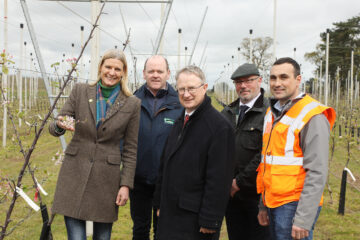Grass growth back on track in the west after 50mm of rain in past week
Heavy rainfall in many parts of the country in recent days will have been greatly welcomed by farmers, but a significant amount is still needed to restore land to workable conditions after one of the longest droughts in Irish history.
An absolute drought is a period of 15 or more consecutive days without 0.2mm or more of rain.
“It only takes 0.2mm of rain per day, or 5.8mm of rain distributed across a 29-day period, to end a partial drought, but from a farming perspective this would provide little relief,” said Paul Downes of the Agricultural Meteorology Unit at Met Éireann.
“Light drizzle falling on hot ground will lead to a lot of that moisture going back into the atmosphere as it evaporates quickly.
“And a heavy downpour could lead to a lot of direct run-off, especially on compacted soil types with ground conditions being extremely firm in many parts of the country.
“Both of the above would not benefit the land well. Instead, steady rain spread out over a number of days would be ideal to allow crops to begin recovery, depending on the conditions and type of crop.”
Rainfall over the past seven days has been above average and the unsettled weather regime will continue up to about midweek.
Parts of the west and north-west have been recording the highest amounts of rainfall, with over 50mm logged at the Knock Airport weather station in the past seven days. Johnstown Castle in Wexford received 40.9mm for the same period.
“There’s definitely a change in the weather pattern and we are starting to make progress,” said Galway dairy farmer and Farming Independent columnist Henry Walsh.
“I walked the land over the weekend and the green has re-established itself in the grass.
“We put fertiliser down two weeks ago in anticipation of the rain, which came, so now we are aiming for a second cut at the end of August which will be about two weeks behind.
“If we can put down fertiliser after that we can aim for a third cut, or use it for grazing. Everyone needs to put a plan in place now for the winter.”
Maize
Gorey dairy farmer Sam Rose said that his area was one of the worst affected in the country, but he is hoping the recent rain will bring some respite.
“There’s a narrow strip along the east coast that got really badly hit and it is going to take some time to recover,” he said.
Mr Rose feeds 100pc maize to his herd of 250 cows, which are housed by day and out by night.
“We have no grass here but we are lucky in that we have enough maize to see us through until the next cut, which could be late September,” he said.
For 70-year-old New Ross dairy farmer Billy Moroney, the recent rains have brought some hope. “We’ve had nothing but hardship down here the past while but at last fortune has smiled down on us and this past weekend we’ve had a nice bit of rain,” he said.
“For a long time the place looked as if it has been sprayed with round-up. Where there was some grass that is starting to come green again.
Mr Moroney cut a small amount of silage earlier in the year, with the aim of buying in the remainder.
“Last week it was not looking great but hopefully now I will be able to get a good supply for the winter,” he said.
New Ross Mart auctioneer Jim Bushe said that the pressure may be off the beef farmer for the moment, but dairy farmers face another tough few weeks.
“There was good trade for strong cattle last Saturday, but the outlook for the dairy sector is still uncertain. A major change in the weather might just avert disaster,” he said.



